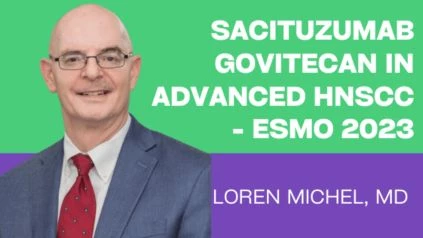By: Loren Michel, MD
Date: October 25, 2023
At the recent ESMO conference, Dr. Loren Michel presented the results of the TROPiCS-03 clinical trial, which investigated the use of sacituzumab govitecan (SG) in advanced head and neck cancer.
The primary and key secondary endpoints in this study held significant importance in assessing SG’s effectiveness in patients with advanced HNSCC. The primary endpoint was the objective response rate (ORR), which stood at 16%. The ORR represents the proportion of patients who exhibited a meaningful tumor response to SG, indicating its potential to shrink or stabilize tumors. The key secondary endpoint, the clinical benefit rate (CBR), was 26%. This CBR encompasses patients with either an objective response or stable disease for a prolonged period, further emphasizing SG’s clinical potential in this heavily pretreated patient population.
The selection of adult patients for this study was based on specific criteria that were essential for evaluating SG’s efficacy. Patients included in the trial had advanced head and neck squamous cell carcinoma (HNSCC) who had progressed after prior platinum-based chemotherapy and anti-PD-(L)1 therapy. These criteria were crucial as they identified a patient population that had limited treatment options, making it imperative to assess SG’s effectiveness in a challenging clinical scenario.
Sacituzumab govitecan (Trodelvy) operates through a unique method of action in head and neck cancer. It is a Trop-2-directed antibody-drug conjugate, meaning it targets cancer cells specifically by binding to the Trop-2 receptor on their surface. Upon binding, the drug is internalized by the cancer cell, where it releases an active metabolite, SN-38, causing DNA damage and cell death. This targeted approach minimizes harm to healthy cells while effectively destroying cancer cells, making it a promising therapy.
SG differs significantly from traditional treatments for advanced HNSCC, especially in patients who have progressed after prior platinum-based chemotherapy and anti-PD-(L)1 therapy. Traditional treatments, such as chemotherapy and immunotherapy, often have limited effectiveness in these patients. SG’s targeted approach and novel mechanism of action offer a new therapeutic option, potentially improving outcomes for those who have exhausted conventional treatments.
In terms of safety, SG demonstrated a favorable profile with no treatment-related adverse events leading to discontinuation. This is a significant advantage compared to some other treatments that can be associated with severe side effects, potentially leading to treatment interruptions or discontinuation. The positive safety profile of SG implies better tolerability and improved patient management, offering hope for those with limited treatment options in advanced HNSCC.

